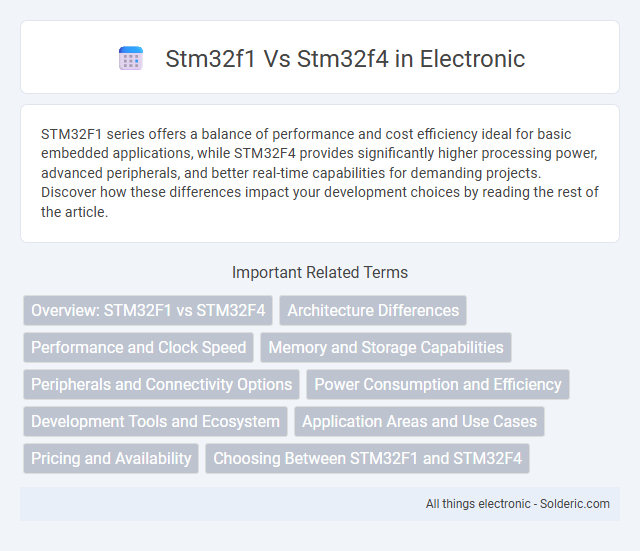STM32F1 series offers a balance of performance and cost efficiency ideal for basic embedded applications, while STM32F4 provides significantly higher processing power, advanced peripherals, and better real-time capabilities for demanding projects. Discover how these differences impact your development choices by reading the rest of the article.
Comparison Table
| Feature | STM32F1 Series | STM32F4 Series |
|---|---|---|
| Core | ARM Cortex-M3 | ARM Cortex-M4 (with FPU) |
| Max Frequency | 72 MHz | 180 MHz |
| Flash Memory | Up to 128 KB | Up to 2 MB |
| SRAM | Up to 20 KB | Up to 384 KB |
| DSP and FPU | No | Yes (DSP instructions and single-precision FPU) |
| Peripherals | Basic timers, ADC, USART, SPI, I2C | Advanced timers, multiple ADCs, USART, SPI, I2C, CAN, Ethernet, USB OTG |
| Operating Voltage | 2.0 - 3.6 V | 1.7 - 3.6 V |
| Target Applications | Basic embedded systems, low power applications | High performance, DSP, real-time control, complex applications |
| Package Options | LQFP, UFQFP, BGA | LQFP, UFQFP, BGA, WLCSP |
| Price | Lower cost | Higher cost |
Overview: STM32F1 vs STM32F4
STM32F1 series offers a reliable, cost-effective solution with Cortex-M3 cores running up to 72 MHz, ideal for basic embedded applications requiring moderate processing power and peripheral integration. STM32F4 series features high-performance Cortex-M4 cores up to 180 MHz with DSP instructions and floating-point units, delivering enhanced computational capabilities for complex, real-time processing and advanced connectivity. Choosing between STM32F1 and STM32F4 depends on Your project's performance needs and power consumption constraints.
Architecture Differences
STM32F1 series features an ARM Cortex-M3 core running up to 72 MHz, optimized for efficient control applications with moderate performance needs. STM32F4 series leverages the more powerful ARM Cortex-M4 core, clocked up to 180 MHz, integrating a floating-point unit (FPU) that significantly enhances signal processing and complex computation tasks. Your choice between STM32F1 and STM32F4 will depend on the required processing power, real-time performance, and computational complexity of your embedded project.
Performance and Clock Speed
The STM32F4 series offers significantly higher performance and clock speeds compared to the STM32F1, with clock frequencies up to 180 MHz versus the STM32F1's maximum of 72 MHz. Cortex-M4 cores in the STM32F4 provide enhanced DSP instructions and floating-point unit support, enabling faster data processing and more efficient computation. This performance boost makes the STM32F4 ideal for complex applications requiring real-time processing and advanced control algorithms.
Memory and Storage Capabilities
STM32F4 microcontrollers offer significantly larger Flash memory and RAM compared to STM32F1 series, with capacities reaching up to 2 MB of Flash and 384 KB of SRAM versus STM32F1's maximum of 512 KB Flash and 96 KB SRAM. The advanced memory architecture of STM32F4 supports higher-speed execution and efficient handling of complex applications, enhancing system performance and responsiveness. STM32F4 devices also provide integrated features like tightly coupled memory (TCM) for faster data access, which is absent in STM32F1 series, optimizing storage capabilities for demanding embedded systems.
Peripherals and Connectivity Options
STM32F1 microcontrollers offer a solid range of peripherals including basic ADCs, timers, UARTs, SPI, and I2C interfaces, suitable for simpler embedded applications. STM32F4 series significantly enhances connectivity options with advanced peripherals such as higher-speed USB OTG, CAN, Ethernet MAC, and more versatile ADCs and DACs, supporting complex communication requirements. Your choice depends on the necessity for advanced connectivity and richer peripheral sets, where STM32F4 stands out for high-performance and feature-rich designs.
Power Consumption and Efficiency
The STM32F1 series features lower power consumption, making it ideal for energy-efficient applications that require minimal power drain. In contrast, the STM32F4 series offers higher performance with optimized power management but consumes more power due to its advanced processing capabilities. Your choice depends on balancing power efficiency with computational requirements for your specific project.
Development Tools and Ecosystem
The STM32F1 series is widely supported by established development tools such as STM32CubeMX, Keil MDK, and IAR Embedded Workbench, offering robust libraries and middleware for basic to intermediate applications. The STM32F4 series benefits from advanced ecosystem features including CMSIS-DSP libraries, enhanced STM32Cube firmware packages, and compatibility with high-performance IDEs like TrueSTUDIO and Atollic, optimizing projects requiring intensive signal processing and real-time control. Both series integrate seamlessly with ST's ecosystem, but STM32F4 provides superior toolchain support for complex developments and broader third-party middleware integration.
Application Areas and Use Cases
The STM32F1 series is commonly used in industrial control, motor drives, and simple embedded systems due to its cost-efficiency and moderate processing power. The STM32F4 series targets high-performance applications such as advanced motor control, digital power conversion, and audio processing, leveraging its Cortex-M4 core with DSP and floating-point capabilities. Both series excel in automotive, consumer electronics, and IoT devices, but STM32F4 supports more computationally intensive and real-time tasks.
Pricing and Availability
STM32F1 microcontrollers are generally more affordable and widely available due to their longer presence in the market and established supply chains. STM32F4 series, featuring higher performance and advanced peripherals, typically commands a higher price but may face tighter availability in certain regions because of increased demand and newer production cycles. Your choice between STM32F1 and STM32F4 depends on balancing budget constraints with required performance and current market stock levels.
Choosing Between STM32F1 and STM32F4
Choosing between STM32F1 and STM32F4 depends on your project's performance and power requirements. STM32F4 offers higher clock speeds up to 180 MHz and advanced features like DSP instructions and floating-point units, making it ideal for demanding applications. STM32F1, with more modest speeds up to 72 MHz and simpler peripherals, suits cost-sensitive designs where power efficiency and basic functionality are prioritized.
stm32f1 vs stm32f4 Infographic

 solderic.com
solderic.com